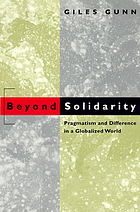
Applying pragmatism to multicultural and global perspectives is also a vibrant area. Mitchell Aboulafia’s The Cosmopolitan Self: George Herbert Mead and Continental Philosophy and Sor-hoon Tan and John Whalen-Bridge’s edited Democracy as Culture: Deweyan Pragmatism in a Globalizing World engage these classical pragmatists in contemporary international issues. Giles Gunn’s Beyond Solidarity: Pragmatism and Difference in a Globalized World seeks unifying pragmatic principles while avoiding hegemonic rights. Without any moral acquiescence, Joseph Margolis embraces the cultural relativism inherent to pragmatism in his Moral Philosophy after 9/11. Parallels between pragmatism and aspects of Eastern philosophy, especially Chinese thought, receive periodic notice. Wei Zhang’s Heidegger, Rorty, and the Eastern Thinkers: A Hermeneutics of Cross-Cultural Understanding is an example, and more direct alliances with Confucius are evident in Sor-hoon Tan’s Confucian Democracy: A Deweyan Reconstruction and Joseph Grange’s John Dewey, Confucius, and Global Philosophy.
By no means less important is pragmatism’s engagement with religion. Although pragmatism’s empiricist and naturalistic leanings do not mesh well with mysticism, transcendentalism, or supernaturalism, a surprisingly large number of pragmatists of each generation attempt humanistic reconciliations between the religious spirit and science’s inquiries. William James supplied a helpful model for such open-mindedness, and the 2002 centenary anniversary edition of his Varieties of Religious Experience elevated attention to new heights. Three collections of new essays appeared in quick succession: Wayne Proudfoot’s edited William James and a Science of Religions: Reexperiencing The Varieties of Religious Experience; Jeremy Carrette’s edited William James and The Varieties of Religious Experience: A Centenary Celebration; and John Capps and Donald Capps’s edited James and Dewey on Belief and Experience. Dewey’s colleague at Chicago, E. S. Ames, has been investigated by Creighton Peden in Christian Pragmatism: An Intellectual Biography of Edward Scribner Ames, 1870-1958. Broader examinations of pragmatism and religion in American thought are offered by Richard Mullin’s The Soul of Classical American Philosophy: The Ethical and Spiritual Insights of William James, Josiah Royce, and Charles Sanders Peirce; M. Gail Hamner’s American Pragmatism: A Religious Genealogy; and Roger Ward’s Conversion in American Philosophy: Exploring the Practice of Transformation. Those seeking an anthology can use Pragmatism and Religion: Classical Sources and Original Essays, edited by Stuart Rosenbaum. Original speculative work abounds at the confluence of pragmatism and religion. Robert C. Neville’s numerous books cannot be listed here, but Realism in Religion: A Pragmatist’s Perspective is a fine place to start. Neopragmatism has kept up—Rorty has been influential, as always—and G. Elijah Dann’s After Rorty: The Possibilities for Ethics and Religious Belief is powerfully suggestive. Rorty’s own views are available in Pragmatism, Neo-Pragmatism, and Religion: Conversations with Richard Rorty, edited by Charley Hardwick and Donald Crosby. Sheila Davaney’s theological pragmatism is a further development of several pragmatist strands; see her Pragmatic Historicism: A Theology for the Twenty-First Century. Finally, looking back on twentieth-century religious naturalism, and projecting speculative trends into the future, is the ambitiously successful book by Jerome Stone, Religious Naturalism Today: The Rebirth of a Forgotten Alternative.
Since its origins in the 1870s, pragmatism has focused on the practical. While continuing to deal with important philosophical issues, as the movement has developed it has become increasingly interdisciplinary, engaging many other fields in the humanities, social sciences, and sciences. The dozens of books published each year reflect continuing interest in the pragmatic approach. Along with books, various websites and journals contribute new content and represent a good way to keep up with the field. In addition to the Works Cited section below, which corresponds to the books discussed in the essay, readers should consult the two lists that follow it—one devoted to important journals, and the other to useful websites.
 Beyond solidarity: Pragmatism and difference in a globalized world
by
Beyond solidarity: Pragmatism and difference in a globalized world
by